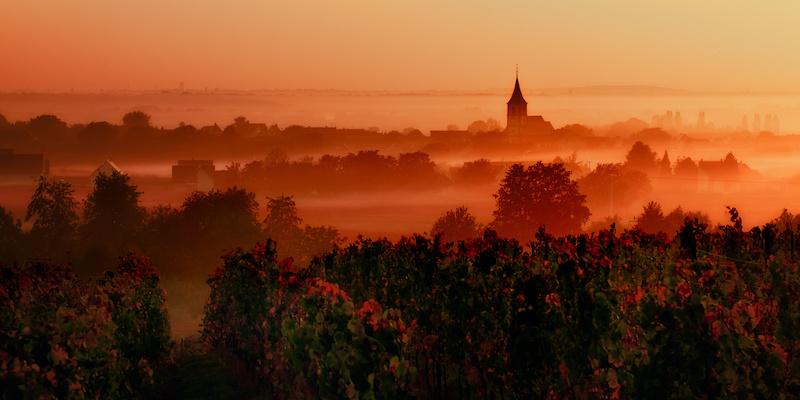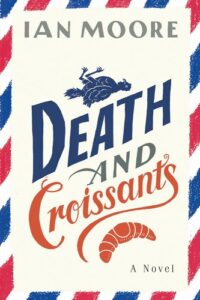Not long after the French language translation of Death and Croissants was released, I was asked to attend a salon de polar, a festival of the ‘whodunnit’, here in rural France. Actually, I was asked not just to attend but to deliver a lecture on what constitutes a ‘cosy crime’ novel, the genre still being quite unheard of here. They wanted an expert’s opinion. Unfortunately, no expert was available, so they got me instead and in my poorly accented French – I did warn them that they could have the right words or a good accent, but that the event of both occurring at the same was unlikely – I gave them some rules.
There must be resolution, the murders should happen ‘off-stage’, no adult themes, specifically sex (several people in the audience rolled their eyes at this and said the genre must be very ‘English’ then), the detectives are generally amateurs, there will be plenty of red herrings and that the setting is all important.
It took me about ten years to realise that I had created, quite by accident, the perfect storm. I had the history, beauty, weather and cuisine of the Loire Valley in France, having moved over from England. I had my background of over twenty years as a stand-up comedian and I had my passion for the crime genre. Put the three together and I had the ingredients for exactly the kind of picturesque comedy caper I like to read or watch.
But where to start?
Firstly, the comedy. England and France have a love-hate relationship built almost entirely, in my opinion, of English jealousy for French meteorology, geography, and romantic and culinary reputation. The French might be jealous of the English, but the French rarely regard anyone except for the French so the data isn’t available. By the way, I can say these things I am both English and French.
For an example of how quirky the French can be take Julia Chapman’s wonderfully evocative Dales Detective series. These books are set in the Yorkshire Dales in the north of England, a very idiosyncratic part of the world, almost unique and the descriptions of what can be a bleak, but beautiful and inspiring, landscape are spot on. The French being the French however, have re-invented the series for French television and transplanted it to Brittany in Northern France.
I wanted this Anglo-French byplay to act as a dynamic between my characters in a gentle, humorous way. That’s why the main male character, Richard, is very English; stiff upper lip, slightly unadventurous, stuck in his ways, and the main female character, Valérie, is very French; instinctive, passionate, dynamic. Together they make not only a formidable team but a comedy, will-they, won’t they? couple.
One of my favorite ‘relationships’ in crime books is between Inspector Montalbano and his long-time girlfriend Livia. Andrea Camilleri’s wonderfully short-tempered Inspector Montalbano is based on the Mediterranean island of Sicily and each sun-bleached investigation is almost a paean to the beautiful island and its people. His girlfriend however, and this may account for his grouchy personality, lives and works on the Italian mainland in Genoa. Camilleri’s descriptions of Sicily are so evocative, you almost feel like the sun is shining on you as read the books.
The two main characters in my books form a working relationship, with generally Valérie taking the detective lead and Richard caught up in her whirlwind, but it’s often forgotten that there is a third main character in the series. This third character is almost as important as Richard and Valérie, and that is the Follet Valley itself. Although I created the fictional Follet Valley it is not so loosely based on the Val de Cher, part of the larger UNESCO World Heritage site of the Loire Valley in France.
The oft-forgotten fact of the Loire Valley is that there are two great rivers running through it, not just the better known namesake. For centuries the Loire, the longest river in France, has been the romantic centerpiece, all regency chateaux and Joan of Arc. The less-heralded Cher, among its tributaries, has done more of the heavy lifting, with man-made trade routes extending further into the valley. The difference between the two rivers could be described as canonization versus canalization.
The idea of a river as the central location initially came from two sources. I live next to the river Cher and know the symbolism great rivers bring to the towns and villages on the banks, but also it comes from one of the all-time great crime books, Death on the Nile. Miss Marple rarely travelled outside of England, but the globe-trotting Hercule Poirot was a different matter. Agatha Christie cannot be bettered in terms of a two-line character description, and she was just as potent with settings. As with Camilleri and his descriptions of Sicily, the sights, sounds and smells of Egypt rise from the page, completely transplanting the reader to the locale. And the wonderful thing about rivers for a writer is that they can look very calm on the surface but there might be plenty going on underneath.
Slightly east of the river Cher, and away from some of the blousier chateaux, is the Chateau de Valençay. Built later than all the other valley chateaux, it reached prominence in the early 19th century when Napoleon asked his first minister and all-round fixer, Charles Maurice de Talleyrand-Périgord, to buy the place and use it as a hub of diplomacy. In the Second World War, the Louvre Museum of Paris hid a myriad of treasures in its cellars; the Germans could do nothing about it as Talleyrand, the family still owned it at the time, were also German royalty, so the chateau was deemed untouchable. (See Death at the Chateau released this year)
Last year there was an exhibition dedicated to its wartime activities, adding to what is a wonderful living museum, with restored gardens and an animal park (plus a very reasonably priced restaurant, L’Orangerie) – all nicely off the beaten track. As is Chabris, nine miles away and back on the Cher. The bridge over the river in Chabris was the border between occupied France and Vichy France in the Second World War, and while nothing much happens there now, there are modest monuments to its strategic past, such as the Circuit Jeannot Bizeau, a guided tour of local Resistance activity named after a resistance fighter from the area. Afew miles up the road is Gièvres, the site of a massive US Army camp in WW1.
Personally I believe that a sense of history for your chosen location is important. It adds depth, gravitas if you like, and authenticity to the story even if your story isn’t a historical one. One of my favorite crime authors is the French novelist and historian Fred Vargas. Her descriptions of place mirror her eccentric characters, whether in Paris, an Alpine village or even Canada and are completely original. But more than that, they come from an author with a real sense of place, one who knows how location can act as an extra character in a story.
Just 10 minutes downriver from Chabris is Selles-sur-Cher. Cheese aficionados may recognise the name as one of the premier goat cheeses, exporting all around the world. Recently Selles-sur-Cher has regained attention in other areas too. Its chateau has been largely renovated and hosts regular cultural and family events throughout the summer, while the 12th-century Abbey, with its exterior carved friezes, dominates the town centre. Selles, as it’s known locally, has just celebrated 1,500 years of patrimoine (heritage) and yet still, blissfully, remains quiet even at the height of summer. The Loire Valley, and thus my own creation the Follet Valley, is chock full of small towns and villages, all with their own personalities, secrets, charms and histories. Again, this is a gold mine for a writer.
The village is a staple of cosy crime and Agatha Christie practically invented the dangerous undercurrent of an English village. The great MC Beaton carried on that tradition magnificently. Her Agatha Raisin novels are wonderful stories beautifully adorned with quirky, modern characters but transplanted to the old-fashioned location of the village, where gossip is king and resentment lasts for generations. French villages are no different, but don’t tell the French that!
So, with all of this on my doorstep, it’s less a question of looking for stories, as being disciplined enough not to overpack them. That’s what I mean when I talk about the setting being an important character, and as such the human characters themselves must be strong enough not to be drowned out by their backdrop. Think of all the great crime books which could never be separated from their location. The underside of LA for Raymond Chandler’s crime noir gumshoe Marlowe, Harlem for Chester Himes’ Harlem Detectives, the various settings employed by Agatha Christie, the Nile, the Orient Express, Paris for Inspector Maigret, Oxford for Colin Dexter’s Inspector Morse series, Venice for Donna Leon’s Commissario Brunetti. In all these works, the setting is absolutely key, an extra dimension and a character that changes as much as any other.
***


















